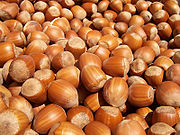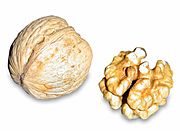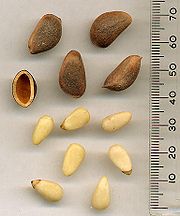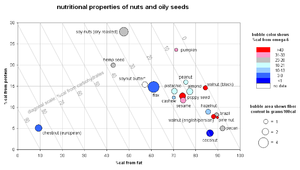
Nut (fruit)
Background to the schools Wikipedia
SOS Children have produced a selection of wikipedia articles for schools since 2005. Child sponsorship helps children one by one http://www.sponsor-a-child.org.uk/.

Nut is a general term for the large, dry, oily seeds or fruit of some plants. While a wide variety of dried seeds and fruits are called nuts, only a certain number of them are considered by biologists to be true nuts. Nuts are an important source of nutrients for both humans and wildlife.
All nuts are seeds, but not all seeds are nuts. Nuts are both the seed and the fruit, and cannot be separated. Seeds come from fruit, and can be removed from the fruit, like almonds, cashews and pistachios, which were once inside fruit.
Botanical definition
A nut in botany is a simple dry fruit with one seed (rarely two) in which the ovary wall becomes very hard (stony or woody) at maturity, and where the seed remains unattached or unfused with the ovary wall. Most nuts come from the pistils with inferior ovaries (see flower) and all are indehiscent (not opening at maturity). True nuts are produced, for example, by some plant families of the order Fagales.
- Order Fagales
- Family Juglandaceae
- Walnut, butternut ( Juglans)
- Hickory, Pecan (Carya)
- Wingnut (Pterocarya)
- Family Fagaceae
- Family Betulaceae
- Alder (Alnus)
- Birch (Betula)
- Hazel, Filbert (Corylus)
- Hornbeam
Culinary definition and uses
A nut in cuisine is a much less restrictive category than a nut in botany, as the term is applied to many seeds that are not botanically true nuts. Any large, oily kernel found within a shell and used in food may be regarded as a nut. Because nuts generally have a high oil content, they are a highly prized food and energy source. A large number of seeds are edible by humans and used in cooking, eaten raw, sprouted, or roasted as a snack food, or pressed for oil that is used in cookery and cosmetics. Nuts (or seeds generally) are also a significant source of nutrition for wildlife. This is particularly true in temperate climates where animals such as jays and squirrels store acorns and other nuts during the autumn to keep them from starving during the late autumn, all of winter, and early spring.
Nuts, including both tree nuts and peanuts, are among the most common food allergens.
Some fruits and seeds that are nuts in the culinary sense but not in the botanical sense:
- Almonds and Walnuts are the edible seeds of drupe fruits — the leathery "flesh" is removed at harvest.
- Brazil nut is the seed from a capsule.
- Candlenut (used for oil) is a seed.
- Cashew nut is a seed.
- Coconut is a dry, fibrous drupe.
- Gevuinanut
- Horse-chestnut is an inedible capsule.
- Macadamia nut is a creamy white kernel ( Macadamia integrifolia).
- Malabar chestnut
- Mongongo
- Peanut is a legume and a seed.
- Pine nut is the seed of several species of pine ( coniferous trees).
- Pistachio nut is the seed of a thin-shelled drupe.
- Lychee is a member of the soapberry family, in which its berrylike fruits can be eaten fresh or sundried as nuts.
See also: List of edible seeds
Nutritional benefits
Several epidemiological studies have revealed that people who consume nuts regularly are less likely to suffer from coronary heart disease. Recent clinical trials have found that consumption of various nuts such as almonds and walnuts can lower serum LDL cholesterol concentrations. Although nuts contain various substances thought to possess cardioprotective effects, scientists believe that their fatty acid profile is at least in part responsible for the hypolipidemic response observed in clinical trials.
In addition to possessing cardioprotective effects, nuts generally have a very low glycemic index (GI). Consequently, dietitians frequently recommend nuts be included in diets prescribed for patients with insulin resistance problems such as diabetes mellitus type 2.
One study found that people who eat nuts live two to three years longer than those who do not. However, this may be because people who eat nuts tend to eat less junk food.
Other uses
The "nut" of horse-chestnut trees (Aesculus species, especially Aesculus hippocastanum), is also known as a conker in some areas (mainly the British Isles). Conkers are inedible, due to the presence of the toxic glucoside aesculin, but are collected and used in an children's game, known as conkers, in which a nut is threaded onto a strong cord and then each child attempts to break their opponent's conker by hitting it with their own. A related species, Aesculus californica, was formerly eaten by the Native Americans of California in times of famine. It must be leached to remove the toxic constituents before eating.




